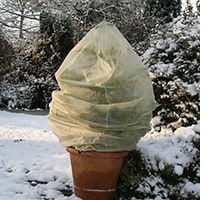Crocus care tips for November

Protecting semi-hardy shrubs and climbers
Most plants grown in gardens in this country are fully hardy and able to cope with the vagaries of the British climate, so they require little or no attention to get them through the more demanding winter months. However, recent gardening fads and fashions have lead to an increase in the popularity of borderline hardy tropical-looking specimens and sun-loving Mediterranean plants, which require a little more TLC to get them through the winter months unscathed. Even some so-called 'hardy' plants can be vulnerable in colder regions and exposed gardens. In any garden however, all new hardy plants that are not fully established can be damaged or killed in a prolonged cold spell, while new growth put on in early spring during a period of mild weather is vulnerable to scorch if the weather turns cold.
But the main threat to borderline hardy shrubs is winter cold, particularly cold winds that will freeze stems and penetrate deep into the soil during a prolonged deep freeze. Also, it is vital the damage caused by excessive winter wet is not overlooked, especially when growing plants that like a well-drained soil. The critical period for protection is from mid-December to the end of February in the south and midlands, but from November until the end of March in the north and more exposed gardens elsewhere. Use the following techniques and the table below to decide which plants to protect in your garden this winter.
Wrapping up
 Vulnerable specimens can be given an enclosure made from windbreak netting that is lined with garden fleece, while not-so-hardy wall shrubs are insulated from the cold by spreading a sheet of fine-mesh netting over the plants and stuffing it with insulating material, such as straw or dry leaves. Alternatively, you could drape the plants with a double layer of garden fleece. Make sure you secure the netting along all sides to prevent it blowing about in windy weather.
Vulnerable specimens can be given an enclosure made from windbreak netting that is lined with garden fleece, while not-so-hardy wall shrubs are insulated from the cold by spreading a sheet of fine-mesh netting over the plants and stuffing it with insulating material, such as straw or dry leaves. Alternatively, you could drape the plants with a double layer of garden fleece. Make sure you secure the netting along all sides to prevent it blowing about in windy weather.
Insulating the roots
Many borderline shrubs and climbers benefit from having their roots protected during prolonged cold spells by covering the surface of the soil with an insulating mulch of dry leaves or compost. This is particularly important while the plant is becoming established, during the first few seasons after planting. Use netting to hold a 15cm deep layer of autumn leaves or straw in place or cover the ground around vulnerable shrubs with a thick mulch or even piles of hedge trimmings.
Protect against wind
Newly planted evergreen shrubs and conifers will suffer during the winter months if they are not given adequate protection, especially in the most exposed spots. Being evergreen they will continue to lose water through transpiration (the loss of water through the foliage), which they have to replace through their roots. Continue to water new evergreens if there is a prolonged spell of dry weather, treating them in much the same way as a winter container plant. Evergreens are also more prone to wind scorch during their early years, so protect exposed plants with a piece of windbreak netting firmly fixed to stout poles.
Insulating containers
You can protect plants in containers from freezing solid in winter by wrapping the containers in bubble polythene and moving them to a sheltered spot. You can also cover the top-growth of susceptible plants and those of borderline hardiness with a double-layer of garden fleece. Don't forget to make sure that you leave access to water evergreen plants over the winter months.
Protecting from winter wet
A few plants, particularly grey- and woolly-leaved ones, are prone to rotting in winter and need protecting if the winter is excessively wet. Small vulnerable plants can be protected with an open-ended cloche (such as the Lily cloche), but in some instances, you'll just have to take the risk and plant replacements in spring if necessary. With larger plants the answer is to choose their planting site carefully so that it is sheltered from heavy rains by the house or a garden fence or wall.
Our A-Z of plants that may need protecting in winter







